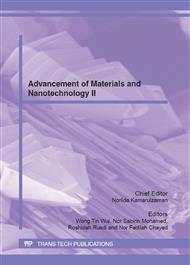p.229
p.235
p.240
p.247
p.251
p.259
p.264
p.269
p.275
Effect of Alloying Elements on the Microstructure and IMC Formation of SnAgCu Solder on Ni (P) Substrate
Abstract:
When the use of lead was banned, the development of lead-free solders began to rise and was greatly explored. Presently, majority of the eutectic Pb-free solders are Sn-based and the most promising is ternary SnAgCu (SAC) solder. However, SnAgCu solder tends to become brittle in nature and excessive solder interfacial reactions. An attractive approach is by introducing alloying elements such as Ce, Fe and Zn into the SnAgCu solder, which allows for an increase of the mechanical properties and refine the solder microstructure as well as improve the wetting properties. The present work focuses on the effects of a series of elemental additions of 0.5% Ce, Fe and Zn into the basic Sn3.0Ag0.5Cu solder, in attempt to reduce the intermetallic compound (IMC) growth as well as joint reliability and reflow properties of the solder on Ni-P surface finish. The intermetallic compound Cu6Sn5, containing a small amount of dissolved Ni, was found to form preferentially on the Ni coating. This compound layer served as a barrier for direct reaction of Sn with the Ni-P coating. The P-rich Ni layer acts as a good diffusion barrier layer, which decreases the dissolution rate of the Ni-P layer hence decreases the growth of IMC thickness layer. It is also expected that with the addition of alloying elements, the wetting properties will be further enhanced.
Info:
Periodical:
Pages:
251-255
Citation:
Online since:
July 2012
Authors:
Price:
Сopyright:
© 2012 Trans Tech Publications Ltd. All Rights Reserved
Share:
Citation:


